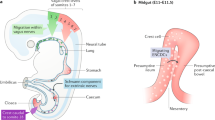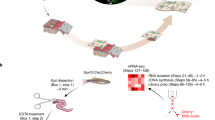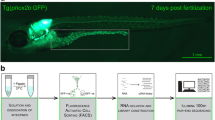Abstract
The enteric nervous system has to adapt to altering dietary or environmental conditions and presents an enormous plasticity that is conserved over the whole lifespan. It harbours neural-crest-derived neurons, glial cells and their precursors. Based on a nestin-green fluorescent protein (NGFP) transgenic model, a histological inventory has been performed to deliver an overview of neuronal and glial markers for the various parts of the gastrointestinal tract in newborn (postnatal day 7) and adult mice under homeostatic conditions. Whereas NGFP-positive glial cells can be found in all parts of the gut at any individual age, a specific NGFP population is present with both neuronal morphology and marker expression in the myenteric plexus (nNGFP). These cells appear in variable quantities, depending on age and location. Their overall abundance decreases from newborn to adults and their spatial distribution is also age-dependent. In newborn gut, nNGFP cells are found in similar quantities throughout the gut, with a significantly lower presence in the duodenum. Their expression increases in the adult mouse from the stomach to the colon. All of these nNGFP cells expressed either (but not both) of the glia markers S100 or glial fibrillary acidic protein (GFAP). In the S100-positive glia population, a subset of cells also shows a neuronal morphology (nS100), without expressing nestin. Thus, the presence of premature neurons that express NGFP demonstrates that neurogenesis takes place far beyond birth. In enteric neurons, NGFP acts as a marker for neuronal plasticity showing the differentiation and change in the phenotype of neuronal precursor cells.










Similar content being viewed by others
References
Azan G, Low WC, Wendelschafer-Crabb G, Ikramuddin S, Kennedy WR (2011) Evidence for neural progenitor cells in the human adult enteric nervous system. Cell Tissue Res 344:217–225
Bassotti G, Villanacci V, Nascimbeni R, Cadei M, Fisogni S, Antonelli E, Corazzi N, Salerni B (2010) Enteric neuroglial apoptosis in inflammatory bowel diseases. J Crohn’s Colitis 3:264–270
Belkind-Gerson J, Carreon-Rodriguez A, Benedict LA, Steiger C, Pieretti A, Nagy N, Dietrich J, Goldstein AM (2013) Nestin-expressing cells in the gut give rise to enteric neurons and glial cells. Neurogastroenterol Motil 25:e67
Belkind-Gerson J, Hotta R, Nagy N, Thomas AR, Graham H, Cheng L, Solorzano J, Nguyen D, Kamionek M, Dietrich J, Cherayil BJ, Goldstein AM (2015) Colitis induces enteric neurogenesis through a 5-HT4-dependent mechanism. Inflamm Bowel Dis 21:870–878
Belkind-Gerson J, Hotta R, Whalen M, Nayyar N, Nagy N, Cheng L, Zuckerman A, Goldstein AM, Dietrich J (2016) Engraftment of enteric neural progenitor cells into the injured adult brain. BMC Neurosci 17:5
Boesmans W, Lasrado R, Vanden Berghe P, Pachnis V (2014) Heterogeneity and phenotypic plasticity of glial cells in the mammalian enteric nervous system. Glia 63:229–241
Butler Tjaden NE, Trainor PA (2013) The developmental etiology and pathogenesis of Hirschsprung disease. Transl Res 162:1–15
Chandrasekharan B, Anitha M, Blatt R, Shahnavaz N, Kooby D, Staley C, Mwangi S, Jones DP, Sitaraman SV, Srinivasan S (2010) Colonic motor dysfunction in human diabetes is associated with enteric neuronal loss and increased oxidative stress. Neurogastroenterol Motil 23:e126
Collins J, Borojevic R, Verdu EF, Huizinga JD, Ratcliffe EM (2014) Intestinal microbiota influence the early postnatal development of the enteric nervous system. Neurogastroenterol Motil 26:98–107
Dahlstrand J, Collins VP, Lendahl U (1992) Expression of the class VI intermediate filament nestin in human central nervous system tumors. Cancer Res 52:5334–5341
Dahlstrand J, Lardelli M, Lendahl U (1995) Nestin mRNA expression correlates with the central nervous system progenitor cell state in many, but not all, regions of developing central nervous system. Brain Res Dev Brain Res 84:109–129
Derkinderen P, Rouaud T, Lebouvier T, Bruley des Varannes S, Neunlist M, De Giorgio R (2011) Parkinson disease: the enteric nervous system spills its guts. Neurology 77:1761–1767
Fichter M, Klotz M, Hirschberg DL, Waldura B, Schofer O, Ehnert S, Schwarz LK, Ginneken CV, Schäfer KH (2011) Breast milk contains relevant neurotrophic factors and cytokines for enteric nervous system development. Mol Nutr Food Res 55:1592–1596
Filogamo G, Cracco C (1995) Models of neuronal plasticity and repair in the enteric nervous system: a review. Ital J Anat Embryol 100 (Suppl 1):185–195
Florenes VA, Holm R, Myklebost O, Lendahl U, Fodstad O (1994) Expression of the neuroectodermal intermediate filament nestin in human melanomas. Cancer Res 54:354–356
Frojdman K, Pelliniemi LJ, Lendahl U, Virtanen I, Eriksson JE (1997) The intermediate filament protein nestin occurs transiently in differentiating testis of rat and mouse. Differ Res Biol Divers 61:243–249
Furness JB (2012) The enteric nervous system and neurogastroenterology. Nat Rev Gastroenterol Hepatol 9:286–294
Geboes K, Collins S (1998) Structural abnormalities of the nervous system in Crohn’s disease and ulcerative colitis. Neurogastroenterol Motil 10:189–202
Hagl CI, Heumuller-Klug S, Wink E, Wessel L, Schäfer KH (2013) The human gastrointestinal tract, a potential autologous neural stem cell source. PLoS One 8:e72948
Hanani M, Ledder O, Yutkin V, Abu-Dalu R, Huang TY, Hartig W, Vannucchi MG, Faussone-Pellegrini MS (2003) Regeneration of myenteric plexus in the mouse colon after experimental denervation with benzalkonium chloride. J Comp Neurol 462:315–327
Hao MM, Young HM (2009) Development of enteric neuron diversity. J Cell Mol Med 13:1193–1210
Hayashi H, Takahashi R, Nishi T, Sakamoto M, Benno Y (2005) Molecular analysis of jejunal, ileal, caecal and recto-sigmoidal human colonic microbiota using 16S rRNA gene libraries and terminal restriction fragment length polymorphism. J Med Microbiol 54:1093–1101
Heanue TA, Pachnis V (2007) Enteric nervous system development and Hirschsprung’s disease: advances in genetic and stem cell studies. Nat Rev Neurosci 8:466–479
Heanue TA, Pachnis V (2011) Prospective identification and isolation of enteric nervous system progenitors using Sox2. Stem Cells 29:128–140
Hendrickson ML, Rao AJ, Demerdash ON, Kalil RE (2011) Expression of nestin by neural cells in the adult rat and human brain. PLoS One 6:e18535
Hotta R, Stamp LA, Foong JP, McConnell SN, Bergner AJ, Anderson RB, Enomoto H, Newgreen DF, Obermayr F, Furness JB, Young HM (2013) Transplanted progenitors generate functional enteric neurons in the postnatal colon. J Clin Invest 123:1182–1191
Jessen KR, Mirsky R (1980) Glial cells in the enteric nervous system contain glial fibrillary acidic protein. Nature 286:736–737
Jessen KR, Mirsky R (2005) The origin and development of glial cells in peripheral nerves. Nat Rev Neurosci 6:671–682
Jiang S, Wang J, Khan MI, Middlemiss PJ, Salgado-Ceballos H, Werstiuk ES, Wickson R, Rathbone MP (2003) Enteric glia promote regeneration of transected dorsal root axons into spinal cord of adult rats. Exp Neurol 181:79–83
Joseph NM, He S, Quintana E, Kim YG, Nunez G, Morrison SJ (2011) Enteric glia are multipotent in culture but primarily form glia in the adult rodent gut. J Clin Invest 121:3398–3411
Jost T, Lacroix C, Braegger C, Chassard C (2013) Assessment of bacterial diversity in breast milk using culture-dependent and culture-independent approaches. Br J Nutr 110:1253–1262
Jost T, Lacroix C, Braegger C, Chassard C (2015) Impact of human milk bacteria and oligosaccharides on neonatal gut microbiota establishment and gut health. Nutr Rev 73:426–437
Laranjeira C, Sandgren K, Kessaris N, Richardson W, Potocnik A, Vanden Berghe P, Pachnis V (2011) Glial cells in the mouse enteric nervous system can undergo neurogenesis in response to injury. J Clin Invest 121:3412–3424
Lendahl U, Zimmerman LB, McKay RD (1990) CNS stem cells express a new class of intermediate filament protein. Cell 60:585–595
Liu MT, Kuan YH, Wang J, Hen R, Gershon MD (2009) 5-HT4 receptor-mediated neuroprotection and neurogenesis in the enteric nervous system of adult mice. J Neurosci 29:9683–9699
Metzger M, Bareiss PM, Danker T, Wagner S, Hennenlotter J, Guenther E, Obermayr F, Stenzl A, Koenigsrainer A, Skutella T, Just L (2009) Expansion and differentiation of neural progenitors derived from the human adult enteric nervous system. Gastroenterology 137:e2064
Mizuno Y, Ohama E, Hirato J, Nakazato Y, Takahashi H, Takatama M, Takeuchi T, Okamoto K (2006) Nestin immunoreactivity of Purkinje cells in Creutzfeldt-Jakob disease. J Neurol Sci 246:131–137
Mohseni P, Sung HK, Murphy AJ, Laliberte CL, Pallari HM, Henkelman M, Georgiou J, Xie G, Quaggin SE, Thorner PS, Eriksson JE, Nagy A (2011) Nestin is not essential for development of the CNS but required for dispersion of acetylcholine receptor clusters at the area of neuromuscular junctions. J Neurosci 31:11547–11552
Nguyen TL, Vieira-Silva S, Liston A, Raes J (2015) How informative is the mouse for human gut microbiota research? Dis Model Mech 8:1–16
Nolte C, Matyash M, Pivneva T, Schipke CG, Ohlemeyer C, Hanisch UK, Kirchhoff F, Kettenmann H (2001) GFAP promoter-controlled EGFP-expressing transgenic mice: a tool to visualize astrocytes and astrogliosis in living brain tissue. Glia 33:72–86
Park D, Xiang AP, Mao FF, Zhang L, Di CG, Liu XM, Shao Y, Ma BF, Lee JH, Ha KS, Walton N, Lahn BT (2010) Nestin is required for the proper self-renewal of neural stem cells. Stem Cells 28:2162–2171
Qu ZD, Thacker M, Castelucci P, Bagyanszki M, Epstein ML, Furness JB (2008) Immunohistochemical analysis of neuron types in the mouse small intestine. Cell Tissue Res 334:147–161
Rauch U, Hansgen A, Hagl C, Holland-Cunz S, Schäfer KH (2005) Isolation and cultivation of neuronal precursor cells from the developing human enteric nervous system as a tool for cell therapy in dysganglionosis. Int J Color Dis 21:554–559
Rauch U, Klotz M, Maas-Omlor S, Wink E, Hansgen A, Hagl C, Holland-Cunz S, Schäfer KH (2006) Expression of intermediate filament proteins and neuronal markers in the human fetal gut. J Histochem Cytochem 54:39–46
Rothman TP, Tennyson VM, Gershon MD (1986) Colonization of the bowel by the precursors of enteric glia: studies of normal and congenitally aganglionic mutant mice. J Comp Neurol 252:493–506
Schäfer KH, Van Ginneken C, Copray S (2009) Plasticity and neural stem cells in the enteric nervous system. Anat Rec 292:1940–1952
Semar S, Klotz M, Letiembre M, Van Ginneken C, Braun A, Jost V, Bischof M, Lammers WJ, Liu Y, Fassbender K, Wyss-Coray T, Kirchhoff F, Schäfer KH (2013) Changes of the enteric nervous system in amyloid-beta protein precursor transgenic mice correlate with disease progression. J Alzheimer’s Dis 36:7–20
Stewart HJ, Cowen T, Curtis R, Wilkin GP, Mirsky R, Jessen KR (1992) GAP-43 immunoreactivity is widespread in the autonomic neurons and sensory neurons of the rat. Neuroscience 47:673–684
Suarez-Rodriguez R, Belkind-Gerson J (2004) Cultured nestin-positive cells from postnatal mouse small bowel differentiate ex vivo into neurons, glia, and smooth muscle. Stem Cells 22:1373–1385
Tsujimura T, Makiishi-Shimobayashi C, Lundkvist J, Lendahl U, Nakasho K, Sugihara A, Iwasaki T, Mano M, Yamada N, Yamashita K, Toyosaka A, Terada N (2001) Expression of the intermediate filament nestin in gastrointestinal stromal tumors and interstitial cells of Cajal. Am J Pathol 158:817–823
Uesaka T, Nagashimada M, Enomoto H (2015) Neuronal differentiation in schwann cell lineage underlies postnatal neurogenesis in the enteric nervous system. J Neurosci 35:9879–9888
Vanderwinden JM, Gillard K, De Laet MH, Messam CA, Schiffmann SN (2002) Distribution of the intermediate filament nestin in the muscularis propria of the human gastrointestinal tract. Cell Tissue Res 309:261–268
Villanacci V, Bassotti G, Nascimbeni R, Antonelli E, Cadei M, Fisogni S, Salerni B, Geboes K (2008) Enteric nervous system abnormalities in inflammatory bowel diseases. Neurogastroenterol Motil 20:1009–1016
von Boyen G, Steinkamp M (2011) The role of enteric glia in gut inflammation. Neuron Glia Biol 6:231–236
Yamaguchi M, Saito H, Suzuki M, Mori K (2000) Visualization of neurogenesis in the central nervous system using nestin promoter-GFP transgenic mice. Neuroreport 11:1991–1996
Yan Y, Yang J, Bian W, Jing N (2001) Mouse nestin protein localizes in growth cones of P19 neurons and cerebellar granule cells. Neurosci Lett 302:89–92
Young HM, Bergner AJ, Muller T (2003) Acquisition of neuronal and glial markers by neural crest-derived cells in the mouse intestine. J Comp Neurol 456:1–11
Author information
Authors and Affiliations
Corresponding authors
Additional information
This work was supported by the Deutsche Forschungsgemeinschaft (DFG), grant number SCHA 878/3-1.
Electronic supplementary material
Below is the link to the electronic supplementary material.
ESM 1
(PDF 1246 kb)
Rights and permissions
About this article
Cite this article
Grundmann, D., Markwart, F., Scheller, A. et al. Phenotype and distribution pattern of nestin-GFP-expressing cells in murine myenteric plexus. Cell Tissue Res 366, 573–586 (2016). https://doi.org/10.1007/s00441-016-2476-9
Received:
Accepted:
Published:
Issue Date:
DOI: https://doi.org/10.1007/s00441-016-2476-9




